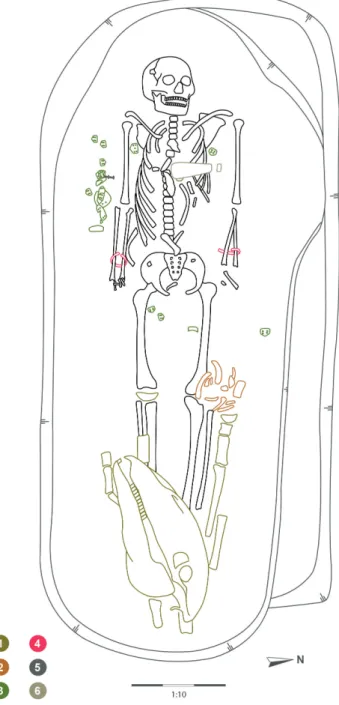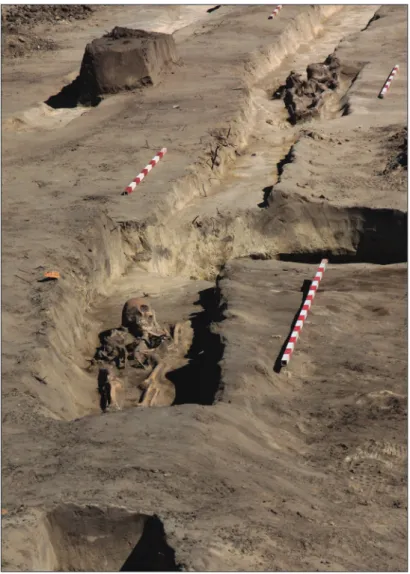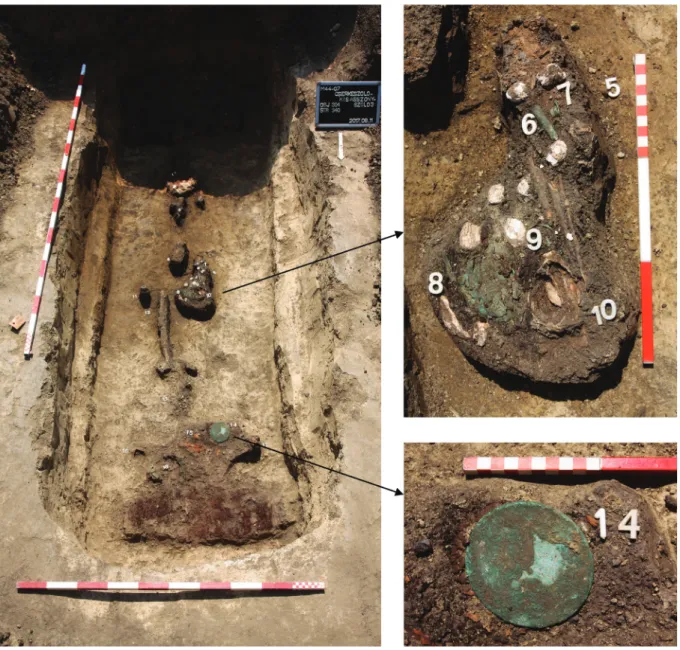Dissertationes Archaeologicae
ex Instituto Archaeologico
Universitatis de Rolando Eötvös nominatae Ser. 3. No. 5.
Budapest 2017
Dissertationes Archaeologicae ex Instituto Archaeologico Universitatis de Rolando Eötvös nominatae
Ser. 3. No. 5.
Editor-in-chief:
Dávid Bartus Editorial board:
László Bartosiewicz László Borhy Zoltán Czajlik
István Feld Gábor Kalla
Pál Raczky Miklós Szabó Tivadar Vida Technical editors:
Gábor Váczi Dávid Bartus
Proofreading:
Szilvia Szöllősi Zsófia Kondé
Available online at http://dissarch.elte.hu Contact: dissarch@btk.elte.hu
© Eötvös Loránd University, Institute of Archaeological Sciences
Budapest 2017
Contents
Articles
András Füzesi – Norbert Faragó – Pál Raczky 7
Tiszaug-Railway-station. An archaic Middle Neolithic community on the Great Hungarian Plain
Zsuzsanna Siklósi – Zsuzsanna M. Virág – Viktória Mozgai – Bernadett Bajnóczi 67 The spread of the products and technology of metallurgy in the Carpathian Basin
between 5000 and 3000 BC – Current questions
Attila Király 83
Grd-i Tle knapped and ground stone artefacts, excavation seasons 2016–2017
Tamás Dezső 97
The arrowheads from Grd-i Tle (Rania Plain, Iraqi Kurdistan)
Bence Soós 113
Early Iron Age burials from Tihany, Hungary
Abdullah Bakr Othman 207
The Middle Assyrian Ceramics at Sheikhi Choli Tomb
Katalin Vandlik 241
Le renard dans les fables antiques et ses représentations
Lajos Juhász 251
Burning money – a coin hoard from Brigetio
Bence Simon 259
Physical landscape and settlement pattern dynamics around Aquincum and Carnuntum – A socio-economic approach
Anna Herbst – Ágnes Kolláth – Gábor Tomka 287
Beneath the Marketplaces. Árpádian Age (10th–13th century) settlement traces from the city centres of Pápa and Győr, Western Hungary
Field Reports
Zoltán Czajlik – Saša Kovačević – Georg Tiefengraber et al. 343 Report on magnetometer geophysical surveys conducted in Hungary, Austria and Croatia in the framework of the Interreg Iron Age Danube project
Tamás Dezső – Gábor Kalla – Barzan Baiz Ismail et al. 361 Preliminary Report on the Hungarian Archaeological Mission (Eötvös Loránd University) at Grd-i Tle (Saruchawa) in Iraq. Second Season (2017)
Márton Szilágyi – Kristóf Fülöp – Eszter Rákos – Nóra Szabó 393 Rescue excavations in the vicinity of Cserkeszőlő (Jász-Nagykun-Szolnok county, Hungary) in 2017
Dóra Hegyi – Gergely Szoboszlay 401
Short report on the excavations in the Castle of Sátoraljaújhely in 2017
Thesis Abstracts
András Rajna 413
Changes in Copper Age Networks of Connections in Light of the Material Excavated in the Danube-Tisza Interfluve
Anikó Bózsa 423
Instruments of beauty care from the Hungarian part of Pannonia
Zsolt Körösfői 439
Die Marosszentanna-Kultur in Siebenbürgen
DissArch Ser. 3. No. 5. (2017) 393–399. DOI: 10.17204/dissarch.2017.393
Rescue excavations in the vicinity of Cserkeszőlő (Jász-Nagykun-Szolnok county, Hungary) in 2017
Márton Szilágyi Kristóf Fülöp
Institut für Vor- und Frühgeschichtliche Archäologie Institute of Archaeological Sciences
Universität Hamburg Eötvös Loránd University
szilagyi.marton84@gmail.com fulopkr14@gmail.com
Eszter Rákos Nóra Szabó
Institute of Archaeological Sciences Institute of Archaeological Sciences
Eötvös Loránd University Eötvös Loránd University
rakoseszter93@gmail.com szabonori91@gmail.com
Abstract
The staff of the Institute of Archaeological Sciences of Eötvös Loránd University carried out full surface excavations in the Summer of 2017 prior to the construction of the M44 motorway in the Tiszazug Region, Jász-Nagykun-Szolnok County, Hungary. This preliminary report presents the most notable uncovered fea- tures and finds.
The staff of the Institute of Archaeological Sciences of Eötvös Loránd University1 carried out full surface rescue excavations at several sites along the future track of the M44 motorway.
These sites were previously investigated with probe trenches in the frames of the second stage of the Preliminary Archaeological Documentation (ERD) in 2015.2 Altogether, we excavated 3.2 hectares (of which ca. 2.7 ha were archaeologically covered) on seven sites between June and August 2017 (Fig. 1).
The processing of field documentation and the finds is currently underway, therefore we can only present a short description of the investigated sites and the most interesting finds. The previously tested M44–03 site had been removed from the road track, M44–04 provided only undatable ditches and in the short and narrow sondages of site M44–08 no archaeological evidence was detectable this time.
M44 01-02 – Tiszakürt-Sziki-Kisföldek
In total, we excavated more than 1.1 hectares in two separate parts on a flood-free terrace si- tuated N–NW from the asphalt road that connects the eastern side of Tiszakürt and National Road 44.
1 The staff of the project were: Dr. Gábor V. Szabó project leader; Dr. Márton Szilágyi, Kristóf Fülöp leaders of the excavations; Eszter Rákos, Nóri Szabó technicians; Dr. András Füzesi, Dr. Gábor Váczi archaeologists;
Dániel Borza, Sára Gábriel, Polett Kósa, Ákos Mengyán, Máté Mervel, Bence Soós, BA archaeologists; Bianka Fenyvesi, Dóra Havasi, Dalma Kerekes, Luca Lakatos, Attila Marsi, Eszter Solnay, Balázs Uhrin BA students.
2 Szilágyi 2015.
394
Márton Szilágyi – Kristóf Fülöp – Eszter Rákos – Nóra Szabó
In the southern trench, we revealed a large, roughly NE–SW orientated ditch, in which we found no datable archaeological material. Beyond that we dug out several pits dated to the Late Avar Period or probably to the 9th century; and an Árpádian Age semisubterranean house with a kiln built partly from stone in its SW corner.
In the northern trench a Scythian Age pit should be mentioned as the earliest trace of habita- tion. In the NW corner of the excavated area we unearthed 15, W/NW–E/SE oriented graves Fig. 1. a – The overview of the mentioned sites in the vicinity of Tiszakürt and Cserkeszőlő on the map of the Second Military Survey, b – Google satellite image of the excavation in progress in July 2017.
Notable features: 1 – Árpádian Age row cemetery, 2 – Middle Neolithic pit-complexes, 3 – Sarmatian enclosure.
a
b
395 Rescue excavations in the vicinity of Cserkeszőlő in 2017
of a presumably larger Hungarian Conquest Period graveyard. During our operations in 2015, we found a burial without any grave goods, which we considered as undatable, it is now very likely that it belongs to the same cemetery. The discolouration of the burial pits in the yel- lowish sandy subsoil was barely visible, or completely invisible, therefore we dug sondages to find more graves. The graves were fairly densely distributed. Notable finds amongst the goods were weaponry (a quiver, iron arrowheads, an iron adze, iron knives), iron parts of saddleries (stirrup, bridle and smaller mountings) and jewellery (bronze and silver bracelets, rings and metal sheets). In two cases we could observe partial horse burials (skull and limb bones) next to the deceased’s legs (Fig. 2). It is highly likely, that the greater part of the cemetery is to be found on the terrace in a N–NW direction. We also excavated several Modern Age pits and ditches in both trenches.
Fig. 2. M44-01-02 – Tiszakürt-Sziki-Kisföldek. A grave from the Conquest Period cemetery with:
1 – horse skull and limb bones, 2 – iron stirrups, 3 – bronze sheets, 4 – bronze bracelets, 5 – twisted bronze wire artefact, 6 – iron adze.
396
Márton Szilágyi – Kristóf Fülöp – Eszter Rákos – Nóra Szabó
M44-05 – Cserkeszőlő-Szőlők
The site is situated on the northwestern border of Cserkeszőlő, on a sandy elevation to the eastern side of the so-called Bába-tói-lapos (lit. Bába-Lake-depression)
The earliest occupation can be dated to the Early Bronze Age. We found altogether 10 features of the Makó Culture scattered across the whole excavation area, except for the western, dee- per part. We recovered pits and find concentrations without any discolouration in the subsoil.
Some of these features were rich in finds, whole profiles of Makó pottery and a fragment of a footed bowl with internal decoration. In one of the pits, three well separated layers were ob- servable. In the upper part of the stratigraphic sequence we recovered a considerable amount of sherds, presumably parts of 4–5 pots. Beneath that, there was an almost sterile layer.
On the bottom of the pit a large number of animal bones were found.
The next occupation phase can be dated to the Late Bronze Age, more precisely to the Pre-Gáva Period. We excavated 6 pits, a partially preserved post-structured building on the slope and the higher parts of the sandhill. Additionally, we recovered a find concentration 60 centimet- res above the subsoil, with fragments of a large biconical vessel that can be doubtlessly dated to the Late Bronze Age. Some more pits provided uncharacteristic Bronze Age pottery finds.
Fig. 3. M44-05 – Cserkeszőlő-Szőlők. Inhumations on the bot- tom of a ditch.
397 Rescue excavations in the vicinity of Cserkeszőlő in 2017
The next settlement phase can be linked to the Sarmatians. Among the pits, ditches and a well, a kiln and an adjacent working pit should be mentioned. Four N–S orientated disturbed, rob- bed graves in the southwestern part of the excavation can be linked to the Sarmatian Period as well. One of the graves contained two skeletons with grave goods such as beads, an iron knife, a bronze fibula, and vessels under the legs.
The most recent use of the area can be dated to the Middle Ages, we excavated 56, W–E orien- tated graves of an Árpádian Age row cemetery. The grave pits were shallow, in a lot of cases no discolourisation was visible, therefore some of the skeletons were found during the removal of the humus layer by the excavator. There was one exception among the ordinary supine inhuma- tions: a small skeleton was laid partly on its chest, the torso was twisted, the wrists were placed tightly next to each other near the hip, and the legs were in a contracted position. In the major- ity of the burials no grave goods were observable, only a few S-shaped bronze lock rings and a simple bronze ring were found. In one case we could observe the remains of a wooden coffin.
Some undatable features were unearthed too. The most interesting of these were two paral- lel N–S orientated ditches. In one of these we found two inhumations in a supine position approximately 5 meters from each other (Fig. 3). In the other, western ditch a skeleton of an infant was discovered a little above the bottom of the trench.
M44-06 – Cserkeszőlő-Homokbánya
The 0.2 ha excavation area consists of several long, 2 meter wide trenches between sites M44-05 and M44-07.
The western trenches were situated on the same sandhill as the site M44-05. In this area we excavated pits dated by a few uncharacteristic prehistoric sherds, Early Bronze Age pits, and a fragment of a footed bowl with internal incision, and some – probably early – Sarmatian pits. To the east from the sandy area, on the loessy subsoil we discovered Middle Neolithic (Szakálhát group of the Alföld Linear Pottery Culture) and Sarmatian pits that undoubtedly mark the western limits of the settlements excavated on the M44-07 site.
M44-07 – Cserkeszőlő-Kisasszony-szőlő III.
The site M44-07 proved to be the most intensely occupied area among the excavated sites.
All in all we unearthed 374 stratigraphical units belonging to 326 features in an area of more than 1.1 hectares (including the previous season).
The earliest occupation of the site can be linked to the Szakálhát group of the Alföld Linear Pottery Culture. The settlement features were concentrated in the western half of the inves- tigated area. We must mention some exceptional features that we discovered. We excavated three huge pit-complexes that contained a considerable amount of finds, additionally, one of them contained a kiln with burnt sidewalls. We also found a large rounded pit with heavily burnt and ashy infilling which provided numerous painted potsherds and fragments of a face pot. Such face pot fragments were also found in an activity area at the westernmost part of the excavation. We discovered six Middle Neolithic contracted burials, two of them were found in the pit-complexes, the rest were scattered among the settlement features. In one of the latter, a small vessel filled with red ochre and some shells were placed around the body (Fig. 4).
398
Márton Szilágyi – Kristóf Fülöp – Eszter Rákos – Nóra Szabó
Some Late Bronze Age pits rich in finds were discovered on the western half of the excavation too. These can be linked to the Tumulus Culture. In one of the pits we found an urn-shaped vessel without ashes.
We could observe features of the Roman Imperial period throughout the whole excavation area. The Sarmatian settlement was cut into two halves by a triple N–S orientated enclosure system. The density of the settlement features was higher and the finds were richer and more varied in the western part and on the eastern edge of the enclosure than in the eastern half of the excavated area. We discovered mainly ordinary rounded pits, but also two wells and some semisubterraean houses.
The graves of the Sarmatian cemetery were not separated from the settlement, however, they were rather evenly dispersed throughout the excavation trench. We found more than 80 gra- ves during the two seasons, the majority of them were robbed. An outstanding undisturbed burial was found near the southern end of the investigated area. In this burial we revealed a bronze mirror, an ornament made of cowrie, some bronze fibulae, an iron knife, beads made of glass and amber and an unfortunately very badly preserved tiny gold filigree. Moreover, we could document the remains of the wooden coffin and wooden parts on the back of the mirror (Fig. 5). The rest of the graves provided ordinary finds such as bronze fibulae and bracelets, iron knives and belt buckles, beads, coins, spindle whorls, ceramic vessels and in one case an iron sword. Only the western limit of the graveyard can be defined with certainty, graves can be expected in all other directions.
The most recent occupation of the site can be dated to the Early Avar period. We excavated six undisturbed inhumations in the southern part of the middle of the excavation area. One of them was rich in finds, we discovered iron saddlery and pressed bronze sheets of a belt set. In another case we observed a considerable amount of animal bones of different species above the skeleton.
M44-09 – Cserkeszőlő-Kisasszony-szőlő V.
The earliest archaeological period of all excavated sites was found in site M44–09. In the two long (150 and 200 metres) and narrow (2 metres) trenches we found two Early Neolithic pits Fig. 4. M44-07 – Cserkeszőlő-Kisasszony-szőlő III. Middle Neolithic burial with a small vessel filled with ochre.
399 Rescue excavations in the vicinity of Cserkeszőlő in 2017
belonging to the Körös Culture. The northern pit provided a huge amount of potsherds with finger-nail impressed decoration, and a steatopyg anthropomorphic clay figurine. We also found some Sarmatian pits.
References
Szilágyi, M. 2015: Test excavations in the vicinity of Cserkeszőlő (Jász-Nagykun-Szolnok County, Hun- gary). Dissertationes Archaeologicae 3/3, 241–243.
Fig. 5. M44-07 – Cserkeszőlő-Kisasszony-szőlő III. Sarmatian grave with cowrie, bronze ornaments, various beads (right top) and a bronze mirror (right bottom).


